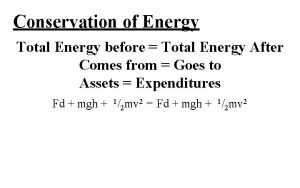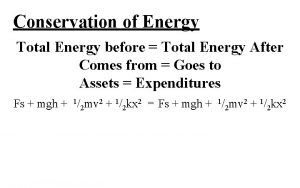MECHANICAL ENERGY MECHANICAL ENERGY The total mechanical energy









- Slides: 9

MECHANICAL ENERGY

MECHANICAL ENERGY: The total mechanical energy of anything is simply the sum of its gravitational potential energy and its kinetic energy. We will discuss each of these types separately and combine them later.

GRAVITATIONAL POTENTIAL ENERGY Observe the ball of mass m sitting on the floor beside a table of height h. Because the floor is the lowest possible position for the ball, we call this level the ground or the zero of potential.

Now suppose that someone lifts the ball up at constant speed and places it on the table. This requires that work be done. A force (the ball’s weight) must be applied through a distance (the table’s height) to do the job

Therefore the work done on the ball = W = Fd = mgh But this work represents the energy that the person has given to the ball. The ball has this energy merely because of its elevated position above the ground. It is now capable of falling and doing some work that it previously could not do. This energy of position is called gravitational potential energy and is given by the equation. Ep = mgh

• Be sure to keep your units straight – mass in kilograms, gravity in newtons per kilogram, and height in metres. • For example in the example described above, the mass of the ball was 1. 5 kg and the table height was 0. 75 m, then the gravitational potential energy of the ball on the table would be • Ep = mgh = (1. 5 kg)(9. 8 N/kg)(0. 75 m) = 11 J

• The ball is now capable of doing 11 J of work that it couldn’t do while on the floor. • Remember that you must know where the ground or zero of potential is before you can calculate the gravitational potential energy of anything

A coconut of mass 1 kg hangs from a tree as shown. If you were asked to calculate the gravitational potential energy of this coconut, you must first identify where the ground or zero of potential is located. If you consider that the base of the tree is the ground, then the gravitational potential energy of the coconut would be Ep = mgh = (1 kg)(9. 8 N/kg)(5 m) = 49 J

However if the head of the person in the boat is taken as the ground, then the coconut has a lot more gravitational potential energy than before. Ep = mgh = (1 kg)(9. 8 N)(25 m) = 245 J If the coconut were to fall, it could do much more work on the person’s head (ouch!) than it could on the ground at the base of the tree.
 Kinetic energy and gravity
Kinetic energy and gravity Law of conservation of mechanical energy
Law of conservation of mechanical energy Total mechanical energy of a swinging bungee jumper
Total mechanical energy of a swinging bungee jumper What is the total mechanical energy
What is the total mechanical energy Formula de roe
Formula de roe Total revenues minus total costs equals
Total revenues minus total costs equals Total revenues minus total costs equals
Total revenues minus total costs equals Total revenues minus total costs equals
Total revenues minus total costs equals Total revenue minus total expenses
Total revenue minus total expenses Useful output power
Useful output power
















